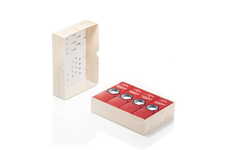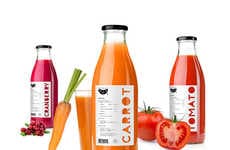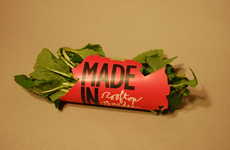
Woolfiller Packaging Reuses Card for Consistency with Brand Values
Amelia Roblin — April 18, 2013 — Marketing
References: coroflot & packagingoftheworld
The brand behind Woolfiller packaging would like to support the culture of consumers who repair their own garments, so it was only fitting that the product should be wrapped up with equal resourcefulness. Lotje Nieuwenhuis and Jan Hellemans of Belgium took up the task of designing an eco-friendly strategy for securely storing delicate items.
A pair of recycled cardboard cylinders are super strong, maintaining their shape to keep the wool wonderfully fluffy. An assortment of different colors can be pushed into each tube, decreasing the number of packages that mending types would need to purchase. To encourage new do-it-yourselfers, Woolfiller packaging also integrates felting instructions into the back of its label, saving on material and recruiting more to its darning movement.
A pair of recycled cardboard cylinders are super strong, maintaining their shape to keep the wool wonderfully fluffy. An assortment of different colors can be pushed into each tube, decreasing the number of packages that mending types would need to purchase. To encourage new do-it-yourselfers, Woolfiller packaging also integrates felting instructions into the back of its label, saving on material and recruiting more to its darning movement.
Trend Themes
1. Eco-friendly Packaging - The trend of eco-friendly packaging presents an opportunity for companies to align their brand values with sustainable practices, like using recycled materials.
2. DIY Culture - The DIY culture trend opens up opportunities for businesses to cater to consumers who prefer to repair and mend their own garments, creating products and packaging that support this movement.
3. Integrated Instructions - The trend of integrating instructions into packaging creates convenience for consumers, reduces material waste, and provides an opportunity for brands to engage with customers on a deeper level.
Industry Implications
1. Packaging Industry - The packaging industry has the opportunity to innovate by developing eco-friendly solutions that align with consumer demand for sustainable packaging materials and practices.
2. Textile Industry - The textile industry can capitalize on the DIY culture trend by offering products and services that empower consumers to repair and mend their own garments, catering to the growing demand for sustainable and personalized clothing options.
3. Instructional Design Industry - The instructional design industry has the opportunity to collaborate with companies to create innovative packaging solutions that integrate instructions, providing a seamless and efficient user experience for consumers.
3.2
Score
Popularity
Activity
Freshness























